Sedimentary Structures
STRATIFICATION refers to the way sediment
layers are stacked over each other, and can occur on the scale of hundreds of meters, and
down to submillimeter scale. It is a fundamental feature of sedimentary rocks.
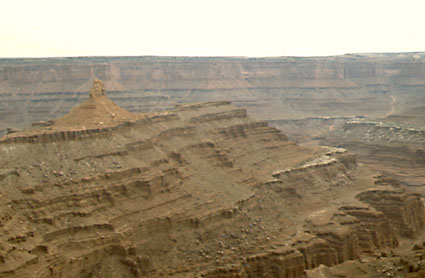
This picture from Canyonlands National Monument/Utah shows strata
exposed by the downcutting of the Green River. Large scale
stratification as seen here is often the result of the migration of
sedimentary environments (see below). Let us imagine a shoreline
that has coexisting slat marsh, beach, and offshore muds. Each
environment is characterized by a different sediment type. If this
shoreline receives more sediment than the waves can remove, it will
gradually build out (to right). Over time the different sediment types
will be stacked on top of each other and the migration of the shoreline
will produce superimposed layers (stratification) of different types of
sedimentary rock. |
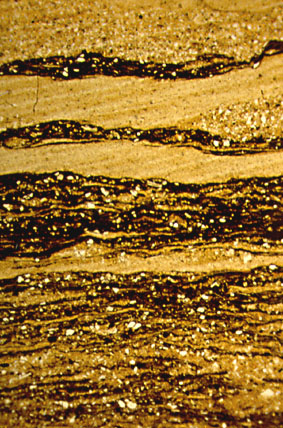 |
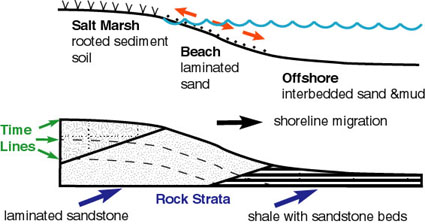 |
Above image shows small scale stratification
in a shale (image is 7 mm tall). This kind of
stratification is due to alternately operating
depositional processes in the same
environment. Dark layers are rich in organic
matter and are remains of algal mats. Light
layers were deposited by storms or floods,
and briefly interrupted algal growth. |
CROSS-BEDDING is a feature that occurs
at various scales, and is observed in conglomerates and sandstones. It reflects the
transport of gravel and sand by currents that flow over the sediment surface (e.g. in a
river channel). sand in river channels or coastal environments
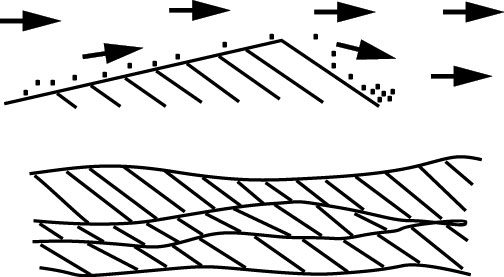 |
When cross-bedding forms, sand is transported as sand-dune like bodies (sandwave), in
which sediment is moved up and eroded along a gentle upcurrent slope, and redeposited
(avalanching) on the downcurrent slope (see upper half of picture at left). After
several of these bedforms have migrated over an area, and if there is more sediment
deposited than eroded, there will be a buildup of cross-bedded sandstone layers. The
inclination of the cross-beds indicates the transport direction and the current flow (from
left to right in our diagram). The style and size of cross bedding can be used to
estimate current velocity, and orientation of cross-beds allows determination direction of
paleoflow. |
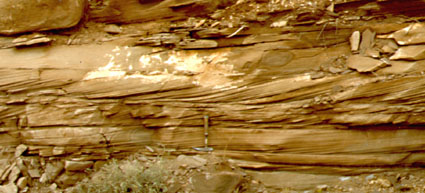 |
Cross-bedding in a sandstone that was originally deposited by rivers. The
deposition currents were flowing from right to left. |
 |
Cross-bedding can also be produced when wind blows over a sand surface and creates
sand dunes. The picture on the left shows ancient sanddunes with cross-bedding. |
GRADED BEDDING means that the grain size
within a bed decreases upwards. This type of bedding is commonly associated with so called
turbidity currents. Turbidity currents originate on the the slope between continental
shelves and deep sea basins. They are initiated by slope failure (see diagram below),
after sediment buildup has steepened the slope for a while, often some high energy event
(earthquake) triggers downslope movement of sediment. As this submarine landslide picks up
speed the moving sediment mixes with water, and forms eventually a turbid layer of water
of higher density (suspended sediment) that accelerates downslope (may pick up more
sediment). When the flow reaches the deep sea basin/deep sea plain, the acceleration by
gravity stops, and the flow decelerates. As it slows down the coarsest grains settle out
first, then the next finer ones, etc. Finally a graded bed is formed. However,
decelerating flow and graded bedding are no unique feature of deep sea sediments (fluvial
sediments -- floods; storm deposits on continental shelves), but in those other instances
the association of the graded beds with other sediments is markedly different (mud-cracks
in fluvial sediments, wave ripples in shelf deposits).
 |
Diagram illustrating the formation of a graded bed (turbidite). Slope failure
produces turbulent suspension that moves/accelerates downslope. Once it reaches the
flat deep sea regions, it slows down due to friction, and gradually the sediment settles
out of suspension. Larger grain sizes settle out first, and then successively
smaller ones. |
 |
Example of a graded bed. Largest grains occur at the base, and the grain size
gradually decreases. |
RIPPLE MARKS are produced by flowing water or
wave action, analogous to cross-bedding (see above), only on a smaller scale (individual
layers are at most a few cm thick).
 |
Current ripples in a creek in Arlington. Ripples are asymmetrical and have a
gentle slop on the right and a steep slope on the left. Comparing with the
explanation of cross-bedding from above, it is obvious that the currents were
flowing from right to left. |
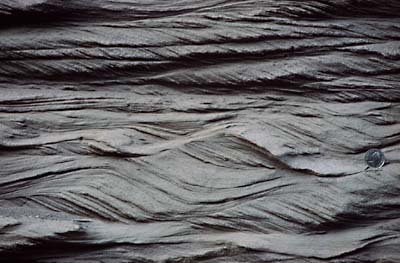 |
Side-view of current rippled sandstone (note coin for scale). The cross-beds or
(more accurately) cross-laminae are inclined to the right, thus the water was flowing from
left to right. |
 |
Modern wave ripples in Lake Whitney. Note that ripples are symmetrical, and that
they can branch in a "tuning-fork" fashion. Both features are
characteristic of wave ripples. |
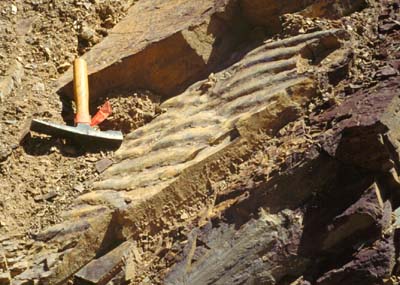 |
Ancient ripples on a sandstone surface. Ripples are symmetrical and show
"tuning-fork" branches. This indicates to a geologist that the sandstones
were deposited in an environment with wave action (nearshore). |
MUD CRACKS form when a water rich mud dries out on
the air.
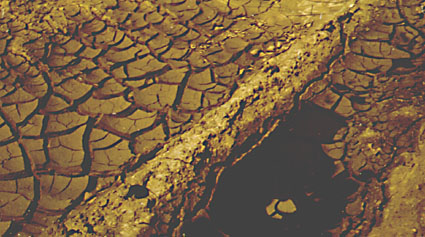 |
You all have seen this when the mud in a puddle dries out in the days following a
rainstorm. This example is from a construction pit in Arlington. Due to
stretching in all directions, the mudcracks form a polygonal pattern. We also see
several successive generations of cracks. |
 |
An example for ancient mudcracks from rocks that are over 1 billion years old
(Snowslip Formation, Montana). Same crack pattern as above, and also second and
third generation cracks. |













